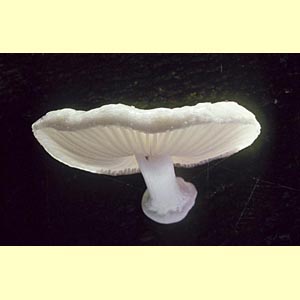
images/Oudemansiella_exannulata/Oudemansiella_mucida.jpg
Small or mostly medium to large agaric, growing on wood, with a white spore print. Pileus white, pale, grey or rarely brown, viscid or glutinous (rarely dry or moist). Lamellae adnexed, adnate or subdecurrent. Stipe central. Partial veil present when young, but at maturity remnants are absent or only as a ring zone, not an annulus (although an annulus is present in some non-Australian species such as O. fibrillosa and O. mucida). Spores large, hyaline, non-amyloid, smooth; germ pore absent. Cheilocystidia present. Lamellar trama regular. Pileipellis an epithelium. Clamp connections present.
Armillaria can have a viscid or glutinous pileus, but the annulus is usually persistent, and the stipe is usually strongly coloured. Moreover, the pileipellis is a cutis or trichoderm.
Flammulina, also on wood and with a viscid pileus, has a velvety, dark stipe and amyloid spores.
Roridomyces and some species of
Mycena have a viscid, usually small pileus and the spores are amyloid. In
Oudemansiella (other) fruit-bodies occur on the ground, attached to buried wood by a pseudorhiza, and a partial veil is lacking.
One species: the endemic
Oudemansiella exannulata. The closely related
O. apalosarca (=
O. australis, type from New Zealand) has been found in India, Sri Lanka and New Zealand and may also occur in Australia. Material from Australia has often been referred to as
O. australis or
O. canarii (a widespread species that occurs as close as Papua New Guinea). Australian records cited in the References below are retained under these names, but most likely refer to
O. exannulata.
Note that Oudemansiella australis is a quite separate species to Xerula australis (currently known as Oudemansiella gigaspora).
Oudemansiella exannulata (Cleland & Cheel) R.H.Petersen,
in Petersen & Hughes,
Beih. Nova Hedwigia 137: 288 (2010).
Qld (e.g.: Lamington NP, Bunya Mountains NP, Eungella NP and Atherton Tableland) and N.S.W. (far north-east, e.g.: Dorroughby, Casino, Kyogle, Coffs Harbour).
In native forests (seems to prefer tropical rainforest).
On wood.
Saprotrophic.
Hood, I.A. (2003),
An Introduction to Fungi on Wood in Queensland. University of New England, School of Environmental Sciences and Natural Resources Management, Armidale. [
Description and
B&W Illustration of
O. apalosarca (as
O. australis)]
Moncalvo, J.-M., Lutzoni, F.M., Rehner, S.A., Johnson, J. and Vilgalys, R. (2000), Phylogenetic relationships of agaric fungi based on nuclear large subunit ribosomal DNA sequences, Syst. Biol. 49: 278–305. [Illustration of O. canarii]
Mueller, G.M., Wu, Q.-W., Huang, Y.-Q., Guo, S.-Y., Adana-Gomez, R. & Vilgalys, R. (2001), Assessing biogeographical relationships between North American and Chinese macrofungi, J. Biogeogr. 28: 271–281. [Molecular data on O. apalosarca (as O. australis) from Australia]
Pegler, D.N. (1986), Agaric flora of Sri Lanka, Kew Bull., Addit. Ser. 12: 1–519. [Description, B&W Illustration and Microcharacters of O. canarii]
Pegler, D.N. & Young, T.W.K. (1987), Classification of Oudemansiella (Basidiomycota: Tricholomataceae), with special reference to spore structure, Trans. Brit. Mycol. Soc. 87: 583–602. [Microcharacters of O. apalosarca (as O. australis) and O. canarii and Key to species of the genus]
Petersen R.H. & Hughes K.W. (2010), The Xerula/Oudemansiella complex (Agaricales), Beih. Nova Hedwigia 137: 1–625. [Description, Microcharacters and Illustration and B&W Illustration of O. exannulata and Description and Microcharactersof O. apalosarca and O. canarii, with Illustration of the latter and Key to species of the genus]
Stevenson, G. (1964), The Agaricales of New Zealand: V, Kew Bull. 19: 1–59 [Description, Microcharacters and Illustration of O. apalosarca (as O. australis) from New Zealand, plate is cited in text as 4/5 but should be 4/4]
Young, A.M. (2005b), A Field Guide to the Fungi of Australia. University of New South Wales Press, Sydney. [Description and B&W Illustration of O. canarii]
Young, A.M., Forster, P.I. & Booth, R. (2002), A preliminary checklist of the macrofungi of the wet tropics and Einasleigh Uplands Bioregions of Queensland, Australia, Australas. Mycol. 21: 16–20. [O. canarii reported from Queensland]


